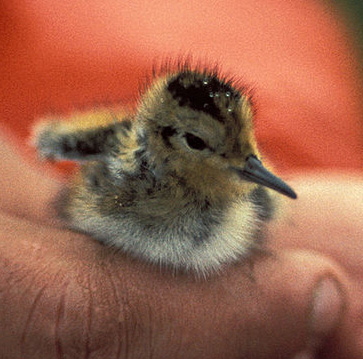

Females arrive on the breeding grounds before males. Like other phalaropes, they practice polyandry with reversed sex roles; breeding females display brighter plumage than males and slightly larger body size. The species is largely non-territorial, but females fight ferociously over males, which provide all parental care. Females establish territories and display to attract mates.Red-necked Phalarope Both sexes start scrapes on mounds or tussocks near the water, and the female picks one. The male adds a lining of grass, sedge, lichen, and leaves in a shallow depression concealed in sedge,ferns, grass, or shrubs. After laying four eggs, the female leaves the male to incubate the eggs and provide all parental care. The male incubates the eggs, cares for the young and therefore displays muted colors. Scientists found a correlation between the aggression of the female, her brighter colors, and her lack of post-natal duties and endocrine levels.
Although they provide no parental duties, females can mate with multiple males each year, and produce up to four sets of eggs. Jaegers, gulls, and foxes are documented sources of mortality for eggs and adults on the nesting grounds; jaegers, dolphins, storms, and El Nino are documented sources of mortality at sea.
In western North America, tens of thousands use hyper-saline lakes as fueling stations on their way south to the Humboldt Current off Peru and Ecuador. In eastern North America, massive flocks totaling millions formerly staged in fall in the western Bay of Fundy; in recent years, these have disappeared. This troubling development remains a puzzle, like much of the pelagic biology of this species. Japanese observers have recorded similar declines in numbers of their populations of migratory phalaropes.
In Alaska, one may see hundreds or thousands of phalaropes in swirling clouds that rise and fall above the sea surface, or forming large lines of swimming birds, in a feeding frenzy.
Though small in stature, phalarope concentrations on the ocean rival any seabird aggregation for intensity and beauty. Here, at the coast, the Red-necked Phalarope entertains us not with massive numbers but with beauty and its frenetic feeding habit. We easily understand the collective nouns for these birds, a "swirl", "twirl", "whirl", and "whirligig" of phalaropes.
Back to ... Mendocino Coast Audubon Society Newsletter Articles | Home page